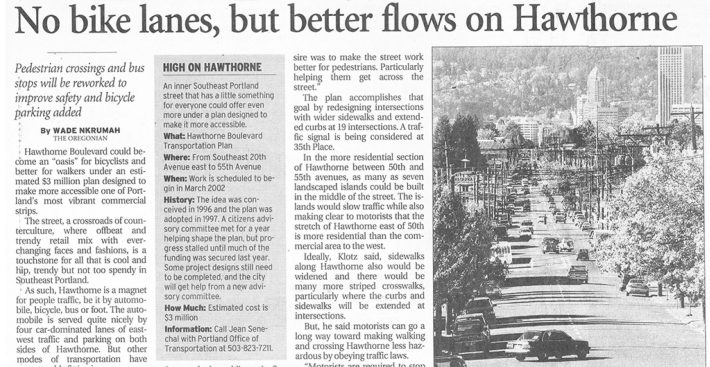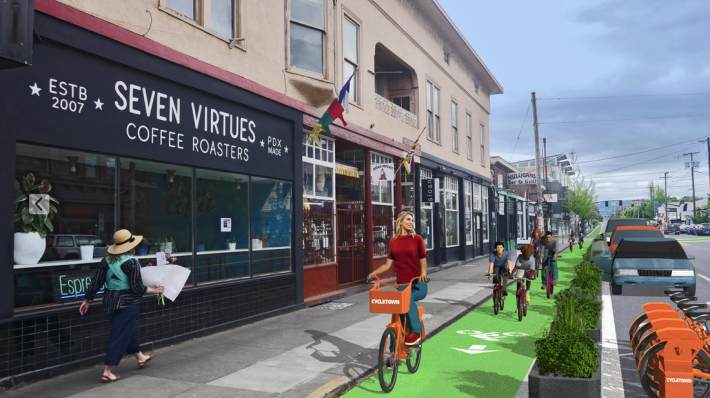Editor's Note: This article originally appeared on Healthier Hawthorne and is republished with permission. It has been edited for length; click through to the original to read the full version, including a point-by-point analysis of the Portland Bureau of Transportation's Decision Report on this project.

Last February, the Portland Bureau of Transportation (PBOT) announced the Pave and Paint Project, with plans to repave and re-stripe Hawthorne Boulevard from SE 24th to SE 50th Ave.
“We are looking to improve safety and better serve businesses on Hawthorne,” PBOT’s Hannah Schafer said. “We know how important Hawthorne is in our road network and we think this is an opportunity to do something big and bold.”
Hawthorne is an extremely dangerous street for people walking, biking, and driving (it's one of the city's High Crash Streets and sees hundreds of crashes every year), so safe streets advocates were excited. “Big and bold,” many thought. “This is Portland, for heaven’s sake. It’s 2020, more people are biking than ever, and it’s even in the city’s official plans. Surely that means they’re going to be adding bike lanes!”
But at the first open house in March — in a room full of slick posters and interactive boards that encouraged people to “put a sticker here if you want more trees!” and “put a sticker there if you want more crosswalks!” — there was no mention of bike lanes. This was the first opportunity to redesign Hawthorne since 1997, and they weren’t even asking anyone if they should include protected bike lanes.

Local street safety advocates sprung into action. A website was made. Business outreach was conducted (most were enthusiastic). Posters were stapled to telephone poles, and local politicians (Sarah Iannarone, Chris Smith, Teressa Raiford, and Sam Adams, to name a few) pledged their support.

In May, as a result of months of activists' volunteer work, PBOT finally decided to consider bike lanes. They released two potential designs: Alternative 3b, which included protected bike lanes, and Alternative 2, which did not.
(There were two other options—Alternative 1 and Alternative 3a—but Alternative 1 proposed keeping the street entirely unchanged, and Alternative 3a proposed unprotected "door-zone" bike lanes, which are proven to be deadly, so we’ll disregard those options).


Unfortunately, Alternative 2 — the one without protected bike lanes — does not meet the real needs of a street like Hawthorne Boulevard. It would not include any way for people to safely bike to and between the homes, parks, schools, and businesses along and near Hawthorne. Instead, it would replicate the current design problem the street faces, where people either bike on the sidewalks (increasing risks at intersections and encroaching on those walking and using wheelchairs) or in the street with buses and trucks (risking themselves). Many people feel so unsafe they avoid the street altogether, weakening our local businesses, or they drive instead, causing congestion and worsening air and noise pollution.


Alternative 3b best aligns with our city’s visions, goals, and policies for this important corridor, lined with hundreds of homes and businesses, ferrying thousands of people each day by foot, wheelchair, scooter, bike, skateboard, bus, and car. Alternative 3b creates one of the best main streets in our region, and a pleasant, safe, and vibrant place for our community. It welcomes and is safe for everyone, no matter how we travel. For the sake of the corridor’s long-term vitality, Alternative 3b is the choice for our community and local businesses.

With overwhelming neighborhood and business support for Alternative 3b, it seemed certain it would be built.
But there were roadblocks ahead. In September, PBOT released its Alternatives Evaluation, along with a public survey where PBOT made strong, graphical claims that bike lanes are bad for both "equity" and "climate."

One might assume that these claims were supported by nuanced, in-depth analysis.
But they weren’t.
Not even a little bit.
Unless you attended September’s Bike Loud PDX meeting or read PBOT’s lengthy Q&A with the Bicycle Advisory Committee, you wouldn’t have known that the sole justification for these claims was a projected transit delay at Cesar Chavez Boulevard — a delay PBOT later admitted would have been resolved by simply including a bus/bike “mixing zone” (a common design tool for PBOT) at that one intersection. Neither the Evaluation Report nor the public survey were ever updated to reflect this.
Shortly after releasing their misleading evaluation and survey, the Hawthorne Boulevard Business Association — unaware of the mixing zone solution — cited “equity and climate concerns” in their letter to PBOT explaining why they can’t support bike lanes on Hawthorne. Local residents, businesses, neighborhood associations, and transit riders in East Portland were given Zoom presentations by PBOT staff and told: Bike lanes are bad for equity. They’re bad for climate, too. Now please fill out this survey and tell us what you think about bike lanes.Despite this setback, public and business support continued to grow for bike lanes. A new petition garnered over 2,500 signatures in less than two weeks. Children made heartfelt pleas for protected bike lanes in order to be kept safe while using the street. Business owners talked about how excited they are for bike lanes to bring them new customers.
But it wasn’t enough. In February, PBOT announced that Commissioner Hardesty had chosen Alternative 2, attributing her decision to many of the claims that PBOT makes in their Decision Report.
Many people and organizations recognize that Alternative 2 was the wrong decision. The Bicycle Advisory Committee and the Planning and Sustainability Commission have each written letters about how PBOT's plan fails to adhere to the Transportation System Plan (TSP) and Bicycle Plan for 2030, and how "there exists a continued chasm between our publicly-stated goals and the outcomes that are achieved."But most people don’t realize the extent to which PBOT fabricated the truth to justify it.?
PBOT used racial equity and climate justice claims—that not only weren’t grounded in any facts, but run completely orthogonal to data-supported equity- and climate-friendly urban planning best practices—to justify a street design that data shows will decrease safety (and/or maintain currently unsafe conditions), and maintain current inequitable and anti-climate outcomes.

Public agencies are hard to keep accountable. Police departments brutalize their communities, water bureaus fail to keep their city’s water free from toxic waste, and transportation departments build and maintain streets that are designed to kill people.
While PBOT has generally upheld a good reputation, the Pave and Paint Project has shed light on their recurring fear of making bold, progressive decisions. We’ve seen this play out with other recent projects (such as not building protected bike lanes on N Denver Ave, citing “concerns” about garbage removal), but the Pave and Paint Project has revealed — with more certainty than ever — their willingness to bend the truth in order to justify those decisions, and their systemic disinterest in taking meaningful action to free our city from the shackles of car dependency.
This isn’t just about adhering to policies or drawing lines on a map. It’s about creating a street that prevents people from dying. And as it stands, Hawthorne is a deadly street to walk, bike, and drive on, and lives and limbs will continue to be lost unless we solve this problem. Alternative 3b offers a chance to make meaningful progress towards achieving this goal.
The best time to build a bike lane was 20 years ago. The second best time is now. With priorities shifting to more urgent streets in East Portland, Hawthorne will likely not have another chance to be made safer for at least another decade. We cannot continue to defer bold, yet necessary decisions to free our city from car dependency and traffic violence. Future generations of Portlanders are counting on us to start doing that work today, and Alternative 3b offers a shovel-ready opportunity to transform Portland into the more walkable, bikeable, transit-friendly city it has so much potential to become.
Announcement: As of April 4th, 2021, we've started a GoFundMe campaign to sue PBOT and hold them accountable for their deception detailed in this article. Please help!






